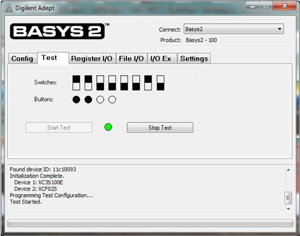Studying generation modes of linearized artificial neurons based on FPGA architecture hardware implementation
DOI:
https://doi.org/10.3103/S0735272720020053Keywords:
Spartan-3E, VHDL, neuronal model, mathematical model of neuron, artificial neuronal model, multistable neural networks, FPGAAbstract
This paper describes the development of embedded software for the implementation and testing of the artificial multistable neuron model’s basic behavior with the help of the hardware architecture of programmable logic integrated circuits (FPGA). The real behavior and function of the biological neuron with linearized activation characteristics are investigated and implemented in the programming language VHD. The base model is a three-stable neuron with three asymmetric dendrites. To develop a hardware model, a computational mathematical model of a neuron is used, based on which a corresponding discrete model is synthesized. The model consists of the following modules: an input block, a timer, a clock generator, a threshold element, and an output signal generator. It is shown that the implemented system allows synthesizing a neural model with a predetermined number of stable discrete states, with the neuron changing its stable state depending on the input vector. Each stable state corresponds to the output function of the neuron. The developed model of artificial neurons was implemented on the DIGILENT BASYS II SPARTAN-3E XC3S100E FPGA kit in the WebPACKTM ISE 13.3 environment. Resulting neuron output generation modes relation from input sequences and structure parameters were studied. The results of the work allow investigating high-speed neural networks with a dynamic structure using FPGA, which can be used for a wide range of modern tasks such as recognition, classification of patterns and development of elements of artificial intelligence.References
- J. A. Bailey, R. Wilcock, P. R. Wilson, and J. E. Chad, “Behavioral simulation and synthesis of biological neuron systems using synthesizable VHDL,” Neurocomputing, vol. 74, no. 14–15, pp. 2392–2406, Jul. 2011, doi: https://doi.org/10.1016/j.neucom.2011.04.001.
- P. Wilson, B. Metcalfe, J. Graham-Harper-Cater, and J. A. Bailey, “A reconfigurable architecture for real-time digital simulation of neurons,” in 2017 Intelligent Systems Conference, IntelliSys 2017, 2018, vol. 2018-January, pp. 66–75, doi: https://doi.org/10.1109/IntelliSys.2017.8324340.
- R. R. Borges et al., “Effects of the spiketiming-dependent plasticity on the synchronisation in a random Hodgkin-Huxley neuronal network,” Commun. Nonlinear Sci. Numer. Simul., vol. 34, pp. 12–22, 2016, doi: https://doi.org/10.1016/j.cnsns.2015.10.005.
- J. E. G-H-Cater, C. T. Clarke, B. W. Metcalfe, and P. R. Wilson, “A reconfigurable architecture for implementing locally connected neural arrays,” in Advances in Intelligent Systems and Computing, 2019, vol. 857, pp. 76–92, doi: https://doi.org/10.1007/978-3-030-01177-2_6.
- I. Sahin and N. K. Saritekin, “A data path design tool for automatically mapping artificial neural networks on to FPGA-based systems,” J. Electr. Eng. Technol., vol. 11, no. 5, pp. 1466–1474, Sep. 2016, doi: https://doi.org/10.5370/JEET.2016.11.5.1466.
- E. Z. Mohammed and H. K. Ali, “Hardware Implementation of Artificial Neural Network Using Field Programmable Gate Array,” Int. J. Comput. Theory Eng., pp. 780–783, 2013, doi: https://doi.org/10.7763/ijcte.2013.v5.795.
- F. Pérez-Peña, A. Morgado-Estévez, and A. Linares-Barranco, “Inter-spikes-intervals exponential and gamma distributions study of neuron firing rate for SVITE motor control model on FPGA,” Neurocomputing, vol. 149, no. PB, pp. 496–504, Feb. 2015, doi: https://doi.org/10.1016/j.neucom.2014.08.024.
- F. Akopyan et al., “TrueNorth: Design and Tool Flow of a 65 mW 1 Million Neuron Programmable Neurosynaptic Chip,” IEEE Trans. Comput. Des. Integr. Circuits Syst., vol. 34, no. 10, pp. 1537–1557, Oct. 2015, doi: https://doi.org/10.1109/TCAD.2015.2474396.
- W. Rawat and Z. Wang, “Deep convolutional neural networks for image classification: A comprehensive review,” Neural Computation, vol. 29, no. 9. MIT Press Journals, pp. 2352–2449, 01-Sep-2017, doi: https://doi.org/10.1162/NECO_a_00990.
- Y. Ghelamallah, D. Chalabi, A. Saïdane, and Z. Chalabi, “Implementation on FPGA circuit of the medical image processing algorithms within the framework of assistance to the medical diagnosis,” Int. Rev. Comput. Softw., vol. 10, no. 10, pp. 987–994, 2015, doi: https://doi.org/10.15866/irecos.v10i10.7155.
- A. Podili, C. Zhang, and V. Prasanna, “Fast and efficient implementation of Convolutional Neural Networks on FPGA,” in Proceedings of the International Conference on Application-Specific Systems, Architectures and Processors, 2017, pp. 11–18, doi: https://doi.org/10.1109/ASAP.2017.7995253.
- S. M. Korogod and D. V. Chernetchenko, “Nature of Electrical Tristability in a Neuron Model with Bistable Asymmetrical Dendrites,” Neurophysiology, vol. 40, no. 5–6, pp. 412–416, Sep. 2008, doi: https://doi.org/10.1007/s11062-009-9067-2.
- Y. M. Snizhko and D. V. Chernetchenko, “Dynamics of electrical potentials of neuron networks models with non-linear activation functions,” Vestnik DNU, v.20, n.2, p.50, 2012.
- A. Alaburda, M. Alaburda, A. Baginskas, A. Gutman, and G. Svirskis, “Criteria of bistability of the cylindrical dendrite with a variable negative slope of the N-shaped current-voltage membrane characteristic,” Biofizika, vol. 46, no. 2, p. 340, 2001, Accessed: 04-Feb-2020. [Online]. Available: http://www.ncbi.nlm.nih.gov/pubmed/11368033.
- S. Yin et al., “A High Energy Efficient Reconfigurable Hybrid Neural Network Processor for Deep Learning Applications,” IEEE J. Solid-State Circuits, vol. 53, no. 4, pp. 968–982, Apr. 2018, doi: https://doi.org/10.1109/JSSC.2017.2778281.


